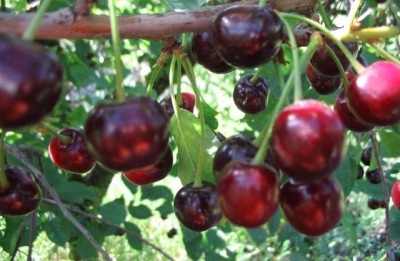
- Authors: Kolesnikova A.F., Dzhigadlo E.N., Zhdanova G.B., Trofimova T.A., Zavyalova A.V.
- Year of approval: 2001
- Barrel type: wood
- Growth type: medium-sized
- Crown: fast-growing, spreading, globular, medium density
- Foliage: strong
- Escapes: straight, brown, naked
- Leaves: obovate, dark green, smooth, shiny
- Flowering and fruiting type: on bouquet twigs and annual growths of the last year
- Fruit size: average
Eaglet is an unpretentious mid-late cherry variety. The main advantage of the variety is its large yield indicators. The eagle is excellent for intensive industrial cultivation.
Breeding history
The eagle was obtained thanks to the efforts of A.F. Kolesnikova, E.N. Dzhigadlo, G.B. Zhdanova, T.A. Trofimova. and Zavyalova A.The. The selection took place at the Russian Research Institute of Breeding. In the course of the work, we used free pollination of the cherry variety Zhukovskaya. Since 2001, the variety has spread widely throughout the Central Black Earth Region. Cherry has a universal purpose.
Description of the variety
Cherry Orlitsa is a tree up to 3 meters high. The culture is medium-sized. The bark has a brown tint and is smooth. Shoots straight and bare, of medium thickness, not too long. The crown is spreading, spherical, moderately thickened. It develops quite quickly.
Dark green smooth foliage covers the branches abundantly. The leaf plates are obovate, glossy. The base of the sheets looks like a wide wedge, the edges are jagged.
Three small white flowers are formed in each inflorescence. Flowers have open corollas. Their cups are narrow-rounded.
Fruit characteristics
Medium Eagles cherries ripen on last year's shoots and bouquet branches. The fruits are heart-shaped, weighing an average of 3.5 grams. The color of both the skin and the fruit is represented by a dark red tint. The pulp of cherries is quite juicy, medium in density. The mass of the stone is 0.28 g, it departs from the pulp quite well. The separation of cherries is average. The appearance of the fruit was estimated at 4.2 points.
Taste qualities
The cherries of this variety were rated 3.8 points in taste. It is sweet and sour, harmonious. The fruits refresh well in the heat, have a delicate aftertaste.
Ripening and fruiting
In the 4th year after planting, the Eagle ripens for the first time. If it blooms ahead of time, it is recommended to pick off the inflorescences. Flowering takes place between May 15-20, and the fruits can be harvested in the 20th of July. In terms of timing, the variety is medium late.

Yield
The eagle is a fairly productive crop. On average, 93 centners of cherries are harvested per hectare of soil, and the best indicators are 284.4 centners per hectare.
Self-fertility and the need for pollinators
Cherry is only partially pollinated, so companion varieties will be needed. The originators recommend planting nearby trees such as Turgenevka, Rovesnitsa, Vladimirskaya, Shokoladnitsa.
Landing
For disembarkation, the Eagles choose zones that are actively illuminated by the sun's rays. The soil should be fertile, well-drained. The best choice is a light sandy loam substrate, but loam will also work. The acidity values are brought to a neutral level by liming.
Planting of seedlings is carried out in the spring, while seedlings aged 2 years showed themselves best in adaptation. Before disembarking, they are kept in water for a couple of hours so that the roots are well saturated with moisture.
The soil for planting the Eagle is always prepared in the fall. If liming has been done, organic matter is introduced into the soil a week later. In the spring, planting holes are dug, the distance between them is 3 meters. The eagle and its pollinators are planted according to the 3x3 m scheme. When working, they follow the classical planting technique. The root collar cannot be deepened. After planting, the seedling is watered, then mulched and a small embankment is built around it. And also the plant will need to be tied to a peg.


Growing and care
Young cherries will require good watering, so irrigate the plants as the soil dries up. Watering is carried out every 7-14 days, depending on the weather and climate. Mature trees should be watered sparingly. Water consumption will be large only at key points of the growing season, such as shoot growth, flowering, and the beginning of fruit ripening.
Top dressing is not applied for the first two years. From the third year of life, the Eagle will already need them. As soon as the tree sheds some of the ovaries, the soil will need to be fertilized with nitrogen. A month later, phosphorus-potassium formulations are recommended. In the fall, organic matter is introduced every couple of years. From foliar dressings for this variety, urea is recommended. 50 grams of urea are diluted in a bucket. There should be at least two treatments, the interval between them is a week. Cherries are sprayed exclusively in the evening.
In addition to the listed procedures, the Orlitsa cherry needs pruning. A sanitary spring procedure is mandatory. It is carried out before the start of sap flow. The molding is also done in the spring. The crown can be shaped in different ways, it remains at the choice of the gardener. Most often, the shoots are pruned so that the crown has the correct spherical shape.


Disease and pest resistance
The eagle is relatively resistant to coccomycosis and moderately resistant to moniliosis. With the use of dirty tools and improper care, the listed diseases can easily affect the tree. And also pests can attack it: aphids, ticks, moths.
To avoid troubles in the spring, the Eagle is treated with urea (7%), it is important to be in time before bud break.After two weeks, the treatment is carried out with insecticides and colloidal sulfur. In the summer they use "Fufanon", as well as copper oxychloride. In the fall, the last spraying is carried out, for this they take a 4% urea solution.
































































